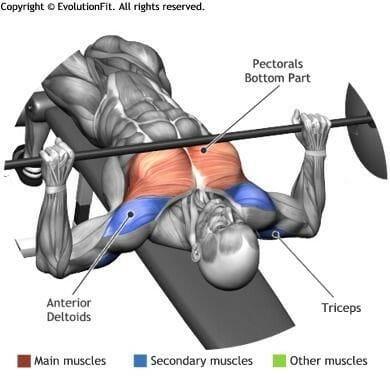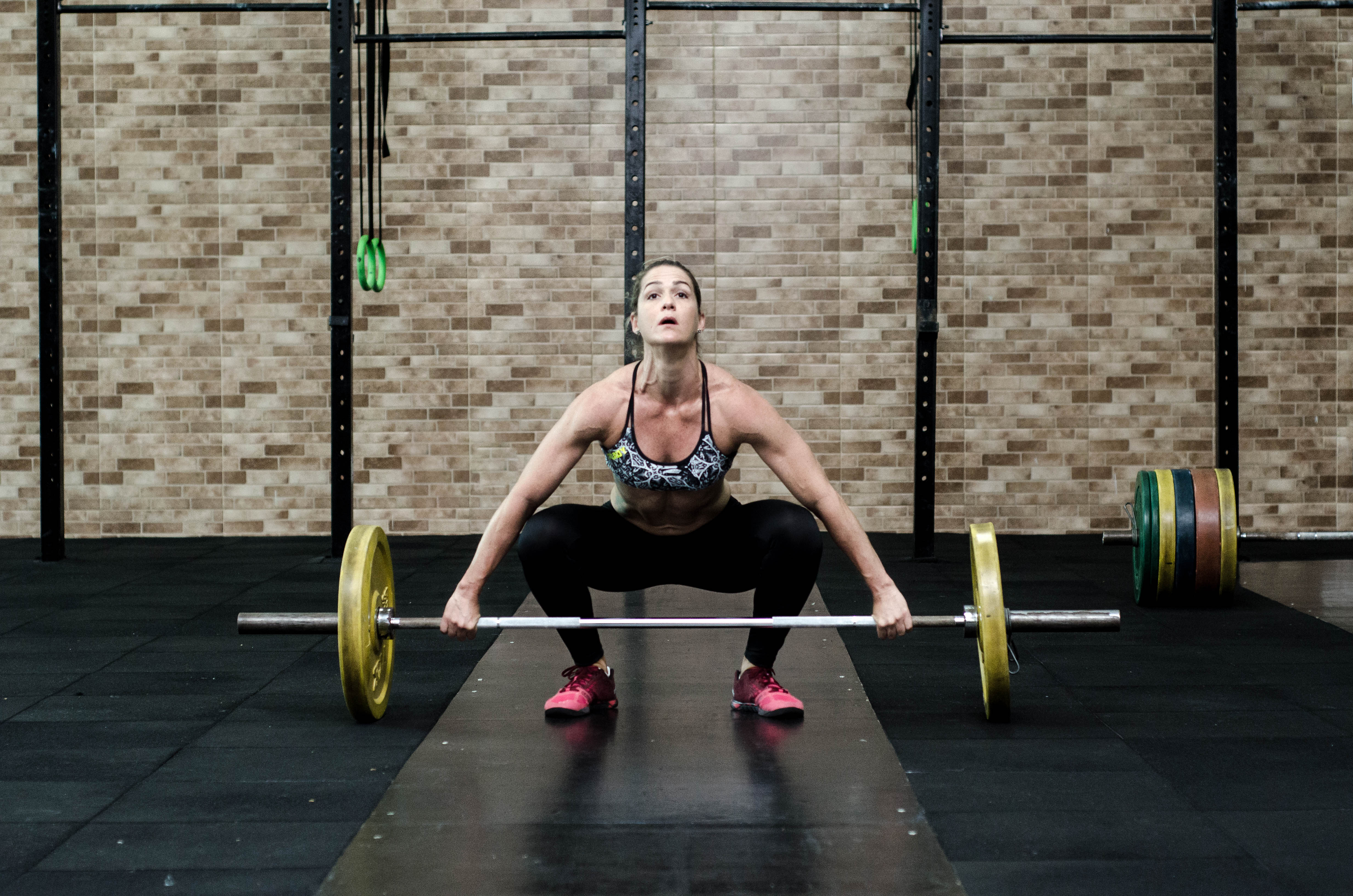Compounds vs isolations – training’s version of the clean eating vs IIFYM debate! By the way, here’s a link to our IIFYM macro calculator to help you optimize your diet. This article, on the other hand, will help you optimize your training. Both compounds and isolations have been included in the training programs of those seeking to optimize body composition over the years.
However, which one is better for muscle gain and fat loss? Is one or a combination of the two better? What does the research say? This article will answer all these questions and more, and put this topic to rest once and for all!
First off, it’s important to define what compounds and isolations are before we go on. Compound exercises target multiple muscle groups, whereas isolations are exercises that target one muscle group. For example, the bench press is a compound exercise as it targets the chest, triceps and anterior deltoid.
Whereas a bicep curl is an isolation exercise as it targets just the biceps. This is where understanding functional anatomy comes into play. Since the joint actions that are being performed will determine which muscle groups are performing the heavy lifting.
It’s also important to understand which muscle groups are being trained in order for you, or your IIFYM coach, to plan effective workout routines. For example, you might train chest one day (including doing the bench press) and arms the next.
In reality, you’ve trained triceps 2 days in a row! This may cause issues with muscle recovery, as most people seem to take at least 48 hours to properly recover from compound exercises (1).
Let’s start with outlining some of the advantages of isolation and compound exercises.

Compound Exercises – Advantages
• Probably the biggest advantage of compounds is that they hit multiple muscle groups at once and therefore count towards volume for each muscle. This is important as the volume is one of the most important factors for muscle growth (2). Therefore, compounds are more efficient per repetition from a global hypertrophy perspective.
• Allow for easier progressive overload. Ever gone from 9kg dumbbells to 10kg dumbbells on lateral raises and found the mere 1kg jump to be significantly harder? Compare this to going from 90kg to 92.5kg on bench press – the jump is much smaller. Therefore, it’s easier/more convenient to progressively overload.
• Can be safely performed in low rep ranges, unlike isolation exercises which don’t lend themselves to low rep ranges. This allows you to target low and high rep ranges in your training, both of which have been shown to cause significant muscle growth (3,4).
• Release more growth hormone and testosterone than isolation exercises (5). Which the most recent research shows might have an impact on muscle growth (6). However, the jury is still out on this, and every second study seems to have a different conclusion.
The Prime Mover
However, it’s not all good news. Every compound exercise has one muscle group that contributes the most to the lift (known as the prime mover). This muscle benefits the most from the exercise. Other muscles benefit as well, but not as much as the prime mover.
Two recent papers on untrained individuals suggest that isolation exercises are not necessary.
This means that compound exercises can create imbalances in the growth of the various muscles involved. For example, barbell shoulder press will hit the anterior delts harder than the middle delts.
So, if this was the only shoulder exercise used, this will likely result in the middle delt being underdeveloped. Which in turn means the trainee will miss that ‘capped’ shoulder look.
In intermediate-advanced trainees who have only ever done compound exercises, it is likely you will see underdeveloped muscles. Such as calves, middle delts and upper traps in particular, compared to the rest of the body.

Isolation Exercises – Advantages
• Better target individual muscles. Compounds don’t always take each muscle through a full range of movement, which is important to maximize muscle growth (7). For example, deadlifts from the floor are claimed to be the ultimate mass builder. Yet, do not take any one muscle through its full range of movement.
• Allow you to increase the volume for specific muscle groups without impacting others that don’t need any more volume. For example, lateral raises to target middle delts, but let anterior delts rest, which is hit with a lot of volume in any pushing/pressing exercise.
• Way to increase volume without increasing central/systemic fatigue as much as compounds. What takes it out on your whole body more – a set of leg extensions to failure or a set of squats to failure? The coaches at IIFYM know the answer to this!
• Safer to take to failure and for higher rep ranges. It is potentially dangerous taking compounds such as deadlifts to failure or to train it in higher rep ranges as fatigue influences form. For example, spinal erectors may fatigue before hamstrings/glutes, putting you at risk of low back injury.
• Help improve activation of individual muscles/mind-muscle connection.
Effect of Training Status
While there are benefits to both isolation and compound exercises, research has shown that training status plays a large role in the need for isolation movements. Untrained people may only need a few sets per muscle group to maximize the stimulus for muscle growth from a resistance training session.
Whereas advanced trainees may need more than double that volume per session (8). This is where isolation exercises come in handy as they allow for more volume with less systemic fatigue. Intelligent coaches, such as the ones at IIFYM, know this well. Let’s take a look at the research on untrained vs trained people.
Studies on Untrained Subjects
Two recent papers on untrained individuals suggest that isolation exercises are not necessary. Since they don’t produce any more hypertrophy than compound exercises that target the same muscle group (9). Interestingly, they don’t provide any extra benefit when performed in addition to compound exercises (10)!
In a 2015 paper by Gentil (9), they took 29 people and split them into 2 groups. One group performed only lat pull-downs for the biceps, while the other performed only bicep curls for the biceps.
They did this training twice a week over 10 weeks, and after 10 weeks there was no difference between groups for bicep muscle thickness. Suggesting that compound upper body exercises are just as useful as isolation exercises for arm muscle hypertrophy.

To take this one step further, Gentil (10) again split 29 people into 2 groups – one group performed only multi-joint (compound) exercises (lat pulldown and bench press). While the other group performed the same compound exercises PLUS single-joint (isolation) exercises (lat pulldown, bench press, elbow flexion, and elbow extension).
After twice a week training over 10 weeks, they found that doing single-joint exercises on top of the multi-joint exercises resulted in no additional benefits in terms of muscle size or strength gain!
Muscle development requires a focused diet and proper training. Have one of our coaches build your Macro Blueprint to help you build muscle!
This led the authors to conclude that “in order to save time we can choose exercises that target a higher number of muscle groups at a time (compound exercises). This strategy can increase training volume and reduce the time commitment.
Which, in turn, may improve exercise adherence since a lack of time is the most cited barrier for an individual engaging in any exercise program (9).” Here at IIFYM.com, our coaches are all about creating strategies to improve adherence for clients!
Study on Trained Subjects
But do these results hold true for trained subjects who may need more volume to grow? de Franca (11) investigated this idea with 20 young men with at least 2 years resistance training experience. They split the subjects into 2 groups – upper body compounds only or upper body compounds plus isolations and performed an 8-week training block.
Both groups significantly increased flexed arm circumference (1.72% vs 1.45%, for compounds and compounds + isolations, respectively). As well as, arm muscle circumference (1.33% vs 3.17% for compounds and compounds + isolations, respectively).
Another significant limitation is that most of the studies to date aren’t long enough to see significant hypertrophy (only 8-10 weeks).
Comparison between groups revealed no statistically significant difference in any variable. The authors concluded that “the addition of single-joint exercises to a resistance training program involving multi-joint exercises does not seem to promote additional benefits to trained men. Suggesting multi-joint only resistance training to be a time-efficient approach.”
However, issues of statistical significance vs real-world significance come into play here. For arm muscle circumference, a 3.17% gain is more than double a 1.33% gain. What trained person who is optimizing their diet through IIFYM wouldn’t want more than double the increase in arm circumference!?

Also, 8 weeks may not be long enough to show up significant differences between groups in trained people. The authors state that “it does thus remain a possibility that significant differences might manifest in trained participants over a longer training duration with the inclusion of single-joint exercises.”
Also interesting is that “the participants of the present study habitually performed single-joint exercises prior to participation and the exclusion of these exercises did not appear to significantly compromise their results.”
Limitations and Other Research
While this research offers some interesting insights, there are a number of important limitations to these studies that need to be acknowledged. One such limitation is that the methods used to measure muscle size (ultrasound and circumference) do not consider non-uniform muscle hypertrophy.
Since previous studies have suggested that isolation and compound exercises result in different patterns of muscle hypertrophy (12). The results of the comparison are limited to the region analyzed and not necessarily representative of the response of the whole muscle.
An evidence-based approach is even more crucial when it comes to your diet. One of our coaches will build your Macro Blueprint based on proven science.
Accordingly, one may argue that performing isolation exercises may be necessary for the complete development of a muscle (13).Furthermore, there is a lack of studies examining the effect of isolation and compound exercise on muscle growth in the lower body.
This is important because it’s possible that the effects may be muscle group specific. As for the lumbar extensors, studies have tended to support the view that this muscle group may benefit from single-joint exercise (13). Therefore, future research should look at the effect of isolation vs compound exercises on muscle growth in the lower body.
Another significant limitation is that most of the studies to date aren’t long enough to see significant hypertrophy (only 8-10 weeks). Therefore, Ribeiro (14) suggested that “to draw more definitive conclusions, further research is required with more sensitive testing methods better suited to detect subtle hypertrophic changes in response to short-term resistance training protocols”.

Concluding the Present Evidence
Furthermore, in contrast to the studies above, other relevant research has highlighted a need for isolation exercises. Ogasawara (15) found that beginners who trained the bench press for 6 months increased their pectoral hypertrophy by ~37% while their tricep hypertrophy only increased by ~21%.
This shows that isolation exercises might need to be added to maximize tricep gains. The IIFYM coaches can certainly show you some great isolation exercises to maximize tricep growth! They’ve helped numerous clients with muscle growth!
Additionally, some studies have shown different muscle activation patterns in isolations vs compounds. For example, higher rectus femoris activation in leg extensions vs squats, and higher vastus lateralis activation in squats vs leg extensions (16).
Finally, one study showed that exercise variety was better for growth than intensity changes. The varied exercise groups presented hypertrophy in all of the quadriceps muscle heads, whereas the constant exercise groups did not (17). Therefore, it might be necessary to hammer a muscle with different types of exercises to maximize muscle growth.
Be sure to check out PART 2 of this article to see the practical applications of this research for your own training, and to explore the effect of compounds vs isolations on fat loss!



